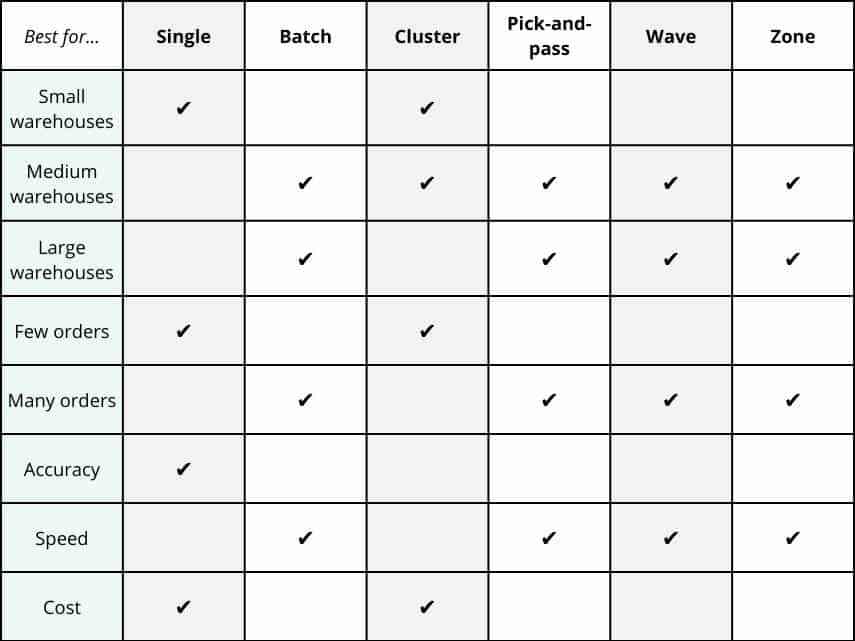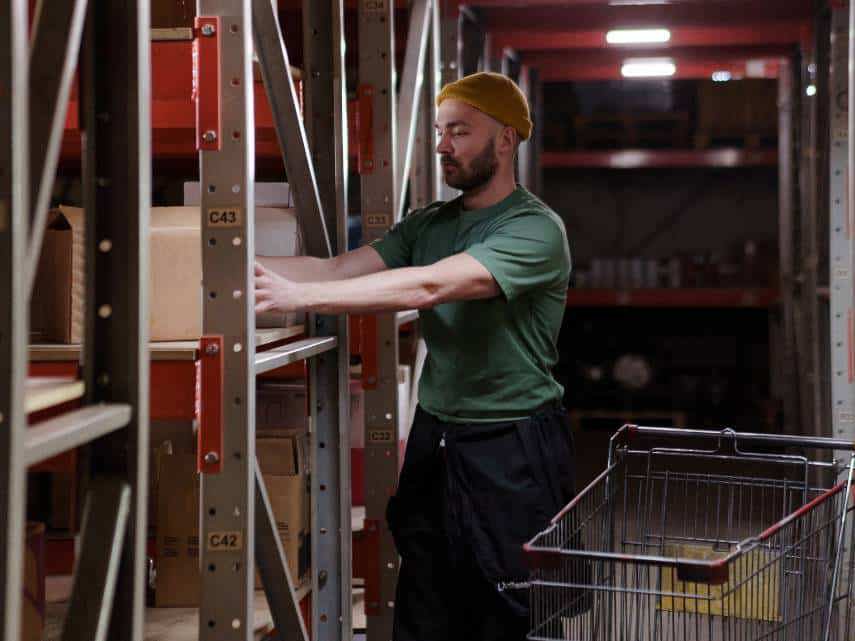
The warehouse order picking method you deploy determines how efficiently and inexpensively your warehouse operates. Add this to the fact picking speed, order accuracy, and labour costs all directly impact your profit margins, and it's easy to see why this is such an important decision to make.
To ensure you choose the optimum approach for your business, first consider the many factors that contribute to warehouse inventory management and order picking efficiency.
What is warehouse order picking?
Warehouse order picking is the process of gathering items needed to fulfil a customer order from their various locations around the warehouse.
An effective picking process can benefit your business by:
- Minimising fulfilment times
- Maximising picking accuracy
- Freeing up space in your warehouse
- Reducing the risk of employee injuries
- Increasing profitability
- Improving brand reputation
Order picking methods are often supported by various warehousing tools and technologies, such as inventory management software, mobile scanners, and carousels.
It’s estimated that order-picking makes up 55% of total warehousing costs, meaning this first step in the fulfilment process is especially important to get right.
 Optimising your warehouse order picking methods can improve accuracy while reducing fulfilment time.
Optimising your warehouse order picking methods can improve accuracy while reducing fulfilment time.
How to find the right order picking method for your warehouse
The best method for your business will depend on the size of your warehouse, your daily order volume, your budget for warehousing costs, and which benefits you value most – accuracy, cost, or fulfilment speed.
Here’s a quick guide to finding the warehouse order picking method that’s best for you:
 The best warehouse order picking methods for your business will depend on size, priorities, order volume, and budget.
The best warehouse order picking methods for your business will depend on size, priorities, order volume, and budget.
From the above chart, we can surmise which order picking method (or combination of methods) will be best suited to different businesses.
The best order picking methods based on warehouse size
- Small warehouses: Single or cluster order picking.
- Medium-sized warehouse: Batch, cluster, wave, or zone order picking.
- Large warehouse: Batch, wave, or zone order picking.
The best order picking methods based on daily orders
- Low daily order volume: Single or cluster order picking.
- High daily order volume: Batch, wave, or zone order picking.
The best order picking methods based on benefits
- If priority = picking accuracy: Single order picking.
- If priority = short fulfilment times: Batch, wave, or zone order picking.
- If priority = spending less on warehouse technology and training: Single or cluster order picking.
You can also combine multiple picking methods to find a strategy that works best for your unique circumstances.
5 main warehouse order picking methods
Most warehouses use one or more of these five order picking methods:
- Single order picking
- Batch order picking
- Cluster order picking
- Wave order picking
- Zone order picking
Let's dive into what these are, the advantages of each method, and some examples of order picking methods in action.
Single order picking method (discrete picking)
Single order picking involves picking all items for a single order before moving on to the next one.
This is often done by printing a pick list and then picking each item as you work your way down the page. It works especially well in small warehouses with a low volume of daily orders.
The pros of single order picking:
- Inexpensive to implement and easy to teach.
- Reduces the risk of items from one order getting mixed up with items from another.
- Works well in small warehouses with minimal travel time between locations.
The cons of single order picking:
- It’s slow and inefficient when you have multiple orders to fulfil.
- Increases the risk of employee injury.
- Can become expensive in terms of labour costs as orders increase.
Let's look at an example of when single order picking might be implemented.
A small, family-owned furniture warehouse sells about eight pieces of furniture per day. Since they’re selling a low volume of goods and don’t have to travel far to retrieve items, they opt for the single order picking method.
A picker prints a pick list for an order of one leather sofa from his inventory management software or spreadsheet system. They pick the sofa base, feet, and cushions individually and bring them to the packing area to prepare for shipping.
Pro tip for single order picking: Organise the line items on your pick list by location. This will cut down picking time as you’ll only have to visit each storage location once per order.
Batch order picking method (multi order picking)
Batch order picking is the process of picking a group, or ‘batch’, of orders by SKU instead of picking each order individually.
In most cases of batch picking, items from multiple pick lists with the same SKU are combined into a single pick task and later split into their separate orders before being packed.
The pros of batch order picking:
- Reduced travel time for the picker when fulfilling multiple orders of the same item.
- You can assign different pickers to different SKUs, making it even simple for them to know their role and perform it well.
- Faster than the single order picking method.
The cons of batch order picking:
- Requires extra investment in warehouse equipment, technology, and training.
- Not suitable for small warehouses.
- Orders must be sorted after picking, which can result in more errors.
Here's a quick example of where batch order picking might come in handy.
A medium-sized stationery wholesaler frequently receives multiple customer orders for the same item. Rather than picking one order at a time, they decide it would be more prudent to implement a batch picking method.
Their picker combines four similar orders into a single pick task. They retrieve the items from all four orders, one SKU at a time, and bring them back to the packing area. This is repeated until all items are gathered. The picker separates the items by order before they are packed and shipped out.
Pro tip for batch order picking: Organise your warehouse layout by product popularity, so that the most in-demand products are nearest to the packing area. This will reduce time spent travelling between locations.
 Batch order picking is quicker than single order picking but comes with an increased risk of picking errors.
Batch order picking is quicker than single order picking but comes with an increased risk of picking errors.
Cluster order picking method
Cluster order picking involves clustering multiple orders and picking the items for them at the same time.
This method is similar to batch and zone order picking, but rather than concentrating on similar SKUs or locations, pickers will pick all items from multiple orders in a single journey around the warehouse.
The pros of cluster order picking:
- Faster than the single order picking method.
- Possible with both minimal warehouse technology (by printing multiple pick lists) and sophisticated warehouse technology (by creating system-generated clusters).
- Can be adopted to work with automated picking equipment like vertical lift modules (VLMs) and carousels.
The cons of cluster order picking:
- Increased risk of items from different orders getting mixed up.
- More time travelling between storage locations.
- Not practical for large warehouses with many product locations.
How does the cluster order picking method look in real life? Let's look at an example.
A small warehouse stocking pet products was using the single picking order method but are now finding the process too slow to meet customer demand. They decide to switch to cluster picking.
Their picker prints off three pick lists and places three containers inside their cart – one for each order. They then move around the warehouse, picking all items from each storage location for each order, and placing them in their respective containers. Once all items for all three orders have been picked, they’re delivered to the packing area.
Pro tip for cluster order picking: When using a method like cluster picking, where there’s an increased risk of mixed-up orders, double-check the picked items against your pick list or install a barcode scanner at the packing desk to catch picking errors before they reach the customer.
Wave order picking method
The wave order picking method is where specific orders that share a common factor are picked at a certain time of day during picking intervals called ‘waves’.
Orders are grouped into waves according to factors such as customer location, order date, or required-by date. These waves are then scheduled to be picked at set times of the day.
The pros of wave order picking:
- Improves picking efficiency when scheduling waves according to factors that will most benefit the business.
- It can be combined with other picking methods, such as single or batch picking.
- You can align picking times with when specific carriers come to collect, maximising the number of orders shipped per day.
The cons of wave order picking:
- Difficult to process last-minute or urgent orders.
- Requires knowledge of complex data, such as the value of prioritising certain shipping carriers or customer types.
- It can create downtime when pickers are forced to wait for the person ahead of them.
Here’s an example of how wave order picking can help a business improve productivity.
A large clothing manufacturer is looking to boost efficiency in their warehouse. They’ve identified that orders from London, UK, should be a priority as they tend to produce the most high-value, repeat customers.
Customer orders are grouped into waves based on where they’re being delivered to. The first wave is comprised of orders being delivered to London. This wave is ascribed to the 7:00 am shift. The pickers working that shift only pick orders from this wave, and any orders that are not picked in time get pushed back to 7:00 am the next day.
Pro tip for wave order picking: You can split orders into waves based on product type, product location, shipping location, shipping company, staffing, warehouse layout, and more. Choose the option that will most improve overall efficiency.
Zone order picking method
The zone order picking method is where a warehouse is divided into multiple physical locations, called ‘zones’, and pickers are each assigned a single zone.
Each picker is responsible for fulfilling the parts of orders containing SKUs that live in their zone. Zone picking is often combined with batch or wave order picking.
The pros of zone order picking:
- Pickers become familiar with items in their zone, which improves efficiency and reduces picking errors.
- Travel time is minimised while productivity is maximised.
- Can be combined with other picking methods, such as single or cluster order picking.
The cons of zone order picking:
- Not suited to small warehouses with a limited variety of products.
- Items are sometimes handled by multiple pickers, leaving more room for human error.
- Requires one scheduling period per shift; orders placed after the cut-off time must be held back until the next shift.
The zone order picking method is quite popular among sellers with a high volume of orders. Take a look at this example.
A medium-sized eCommerce business specialising in board games has a sudden surge in demand. They wish to increase productivity to match this uptake, so they split their storage locations into zones and assign different pickers to each zone.
A picker assigned to Zone C receives a pick list containing part of an order – just the items that live in Zone C. They pick these items and add them to a partially picked order given to them by the picker in Zone B. The order is now complete, so they take all the items over to the packing area to be shipped.
Pro tip for zone order picking: Rotate pickers between different zones on a quarterly or monthly basis. This will prevent employees from begrudging others for their allotted zone and create competent backup workers for different zones should somebody call in sick.
 Keeping picking areas clear and organised is key to a successful zone order picking system.
Keeping picking areas clear and organised is key to a successful zone order picking system.
Other warehouse order picking methods to consider
There are a few more picking methods that can be used instead of or alongside the five we just mentioned. If your business has special requirements that go beyond the capacity of the methods above, you may wish to consider these options as well.
Pick-and pass order picking method
This is a type of zone order picking in which orders are passed down from one zone to another as pickers pick the items found in their designated zone.
Order consolidation picking method
This is a type of zone order picking where all pickers pick multiple SKUs simultaneously, working from the same wave of customer orders. Instead of passing the items on to the next zone, as with pick-and-pass order picking, items are sent directly to the packing area for consolidation.
Third-party logistics (3PL)
One method for simplifying your picking process is to outsource it to a 3PL. 3PL companies operate as a middleman between supplier and customer, managing the entire fulfilment process from their own warehouse or storage location on your behalf.
Order picking automation: Methods and tools
With the right technology, you can automate and optimise your warehouse order picking process.
Automated warehouse picking can boost productivity, improve safety and accuracy, and allow you to be more flexible with where you store your goods.
Here are 5 common automated order picking methods to consider:
- Pick-to-light order picking. This method works by installing pick-to-light LEDs around your warehouse. A picker scans a barcode associated with the order they’re about to pick, triggering the LEDs corresponding to each item on the order. The LEDs start to glow, giving the picker a visual picking path to follow.
- Voice order picking. The voice picking method involves a picker receiving verbal instructions through a headset. They’ll be told which items to pick and their locations in real-time, minimising downtime and reducing the risk of errors.
- Mobile scanner order picking. This method requires that all items in the warehouse have unique barcodes. Pickers are equipped with mobile barcode scanners that display the items they need to pick and their respective locations. A picker will scan each item as they pick them, and the scanner will alert them of any picking errors as they go along. This method helps to improve picking accuracy and minimise time spent looking for items.
- Order picking robots. These are robots that pick orders in an automated, programmatic way. They can improve accuracy and efficiency by being programmed to retrieve items from an order without the need for human interference. Order picking robots come in a variety of forms, from simple mounted robot arms to highly customisable AS/AR systems.
- Order picking software. One of the first steps you can take to automate your picking process is to install inventory management software. This software will cut labour costs and boost productivity by converting customer orders into automatically generated pick lists that contain product SKUs, quantities, and warehouse locations.
 Modern warehousing technologies, such as robots, can be utilised to reduce picking times and human errors.
Modern warehousing technologies, such as robots, can be utilised to reduce picking times and human errors.
Warehouse order picking software: What you’re looking for
If want to improve your order picking process, you’ll need to get an order management system in place first.
Inventory management software like Unleashed makes the fulfilment process simple, efficient, and fast by automating many of the tasks involved in processing customer orders and acquiring new stock.
When deciding which order picking software is right for you, consider:
- Your monthly budget – Can you afford it?
- The ROI of implementing and using the new software – Is it worth it?
- Complexity and training time – Is there a less-complex, easier-to-learn alternative that has all the features you need?
- Scalability – Does the software have the capacity to scale alongside your business? Are there tiered pricing options?
- Flexibility – Are there sufficient customisation options to perform all the tasks you need?
